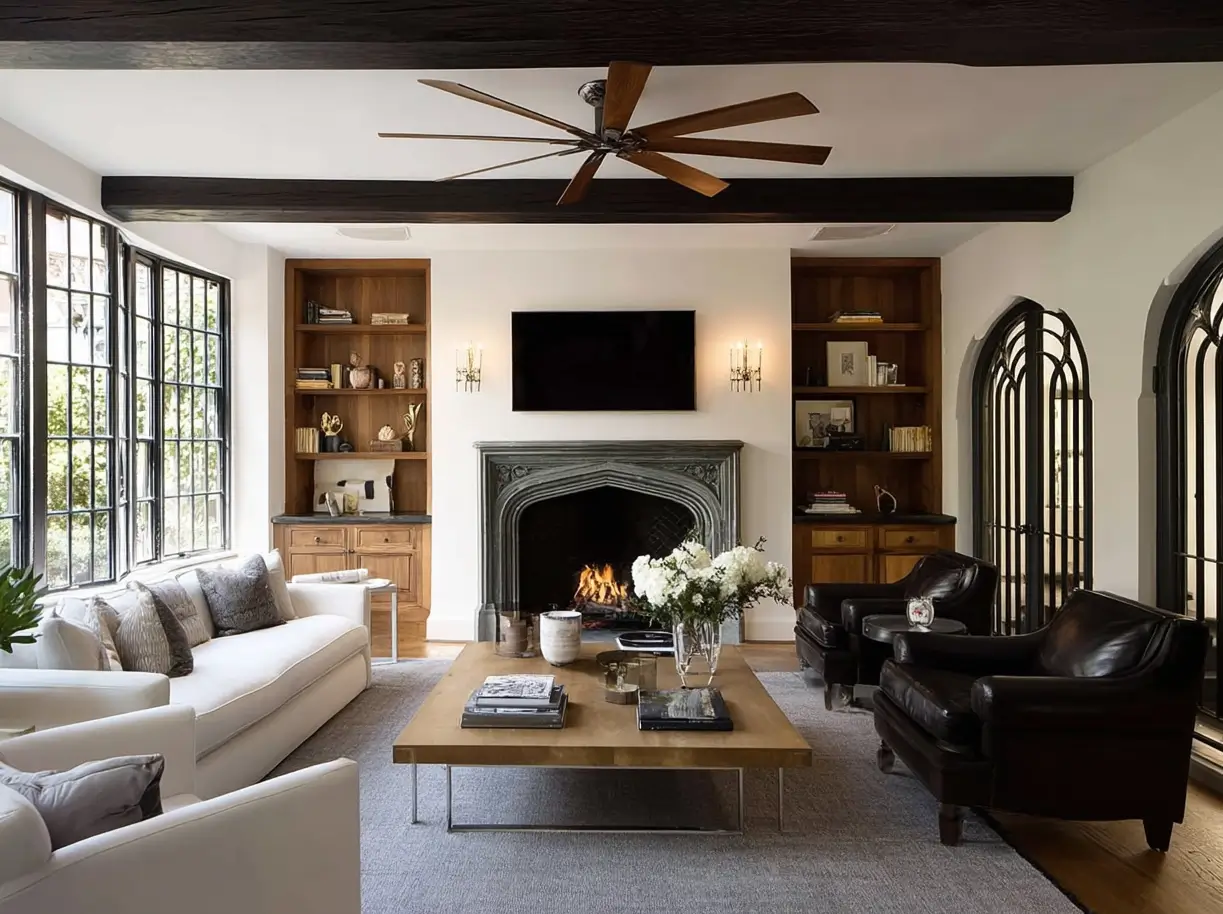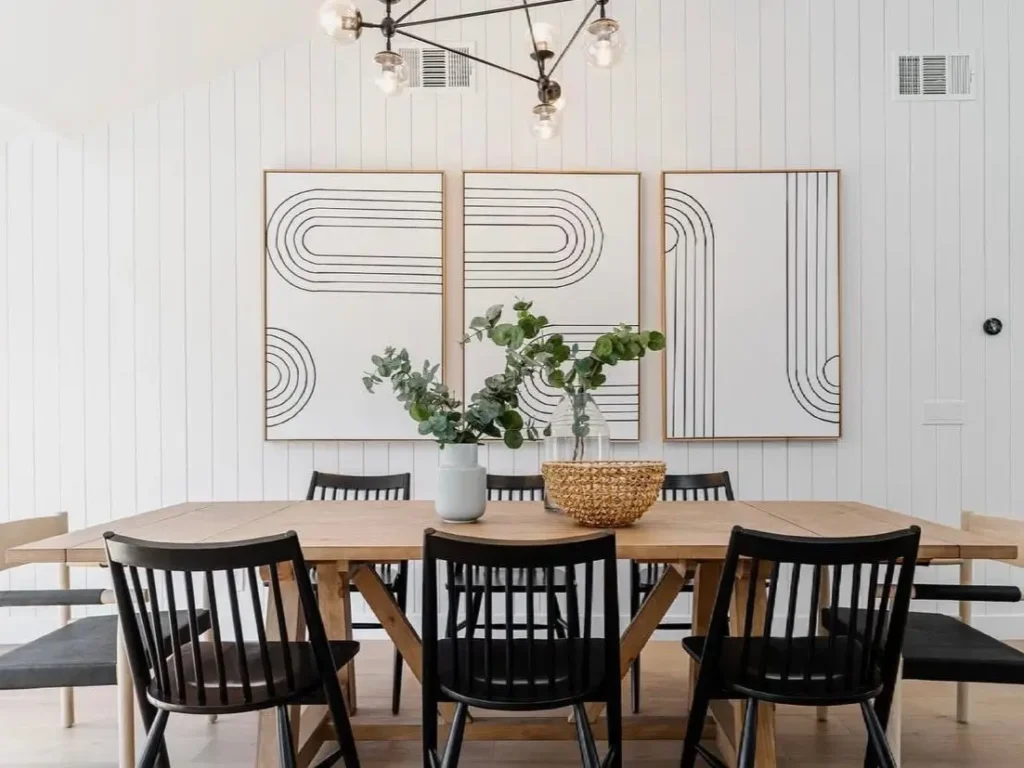Classic Tudor homes are defined by their grand, historical character, from dramatic half-timbering to rich, dark-wood paneling. While magnificent, these heavy features present a distinct design challenge. This is the precise work of modern Tudor interior design: artfully navigating the line between preservation and progression.
This philosophy enhances, rather than erases, the home’s inherent soul. It involves a thoughtful synthesis of original architectural integrity with clean lines, amplified natural light, and modern comfort. The goal is a layered space that feels both grounded and decidedly fresh.
Achieving this balance is the key to updating a Tudor house interior design. This guide provides the essential insights and inspiration to manage dark woods, select furnishings, and cultivate a Tudor style house interior that feels both timeless and perfectly current.
The Key Principles of Modern Tudor Design
Before we explore the visual inspiration, it’s helpful to understand the core principles of this style. This is a look defined by a sophisticated blend, not a historical recreation. It relies on four key pillars:
- The Power of Contrast: This is the most critical element. Modern Tudor design balances the traditional heavy, dark wood (trim, beams, paneling) with crisp white, cream, or light neutral walls. This contrast instantly modernizes and lightens the space.
- Celebrating Original Architecture: Instead of covering or removing them, this style celebrates the ‘bones’ of a Tudor Revival home (the formal name for most U.S. Tudor styles). Leaded-glass windows, grand stone fireplaces, exposed beams, and dramatic arches are treated as the main focal points.
- A Focus on Natural Texture: Honesty in materials is essential. Think rustic wood, whitewashed or limewashed stone, textural plaster walls, and classic herringbone floors paired with rich, soft textiles like velvet, linen, bouclé, and leather. This layering adds warmth and prevents the design from feeling cold.
- The Modern Counterpoint: To achieve the “modern” half of the equation—a concept shared by styles like the Modern Craftsman house—furniture should be sculptural, uncluttered, and comfortable. Minimalist silhouettes, contemporary lighting, and large-scale abstract art provide the perfect counterpoint to the historic architecture.
29 Modern Tudor Interior Ideas in Practice
Here are curated ideas that illustrate the beautiful balance of classic Tudor architecture with contemporary style, providing a blueprint for your own Tudor house interior design.
In Living Spaces & Great Rooms
1. Balance Dark Trim
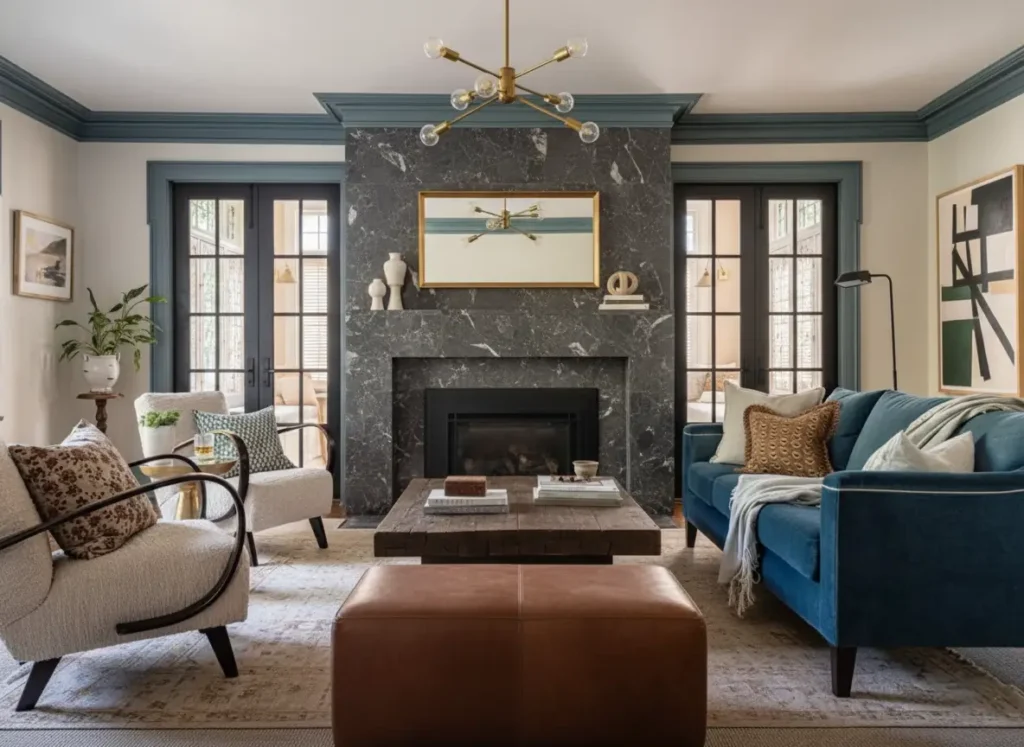
Deeply saturated trim, a hallmark of classic Tudor homes, becomes a sophisticated anchor when paired with bright, neutral walls. This contrast grounds the room, allowing modern furniture—like the bouclé chairs and velvet sofa—to feel intentional rather than out of place.
2. Artful Modern Update
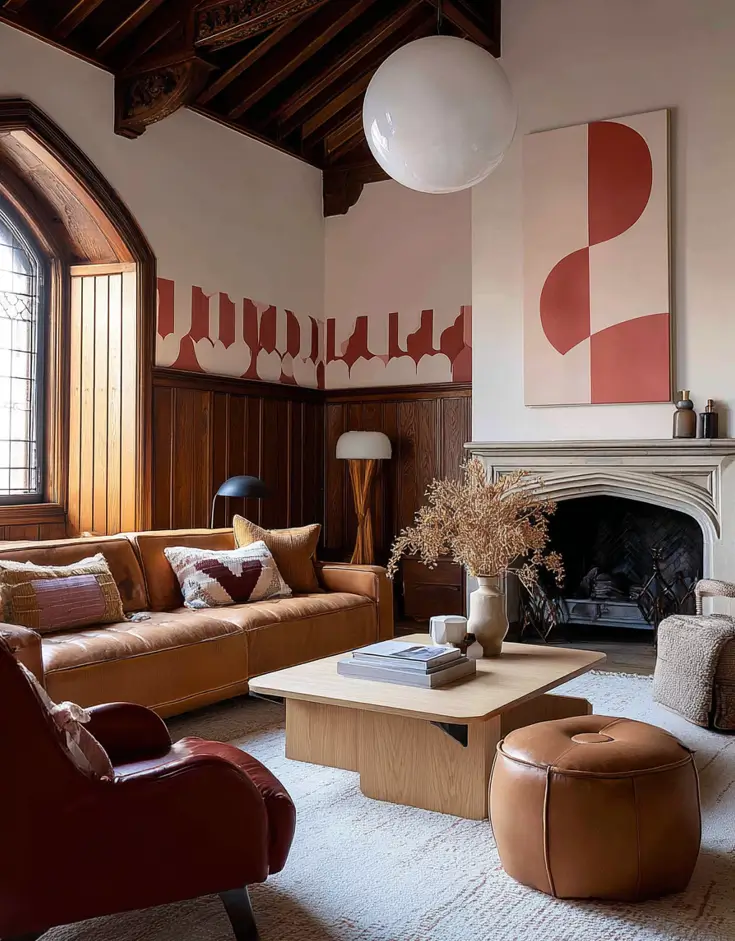
Original wood-paneled walls and carved fireplaces gain new life when contrasted with contemporary pieces. Large-scale abstract art and a minimalist globe pendant introduce clean, modern lines, effectively balancing the room’s historic weight—a key goal of modern Tudor interior design.
3. Balance with Art

Heavy half-timbering, a classic Tudor feature, is beautifully offset by bright white walls and large-scale contemporary art. This pairing creates a visual counterpoint, allowing the room to feel both historic and modern. Light-hued furniture further softens the space.
4. Embrace Grand Scale
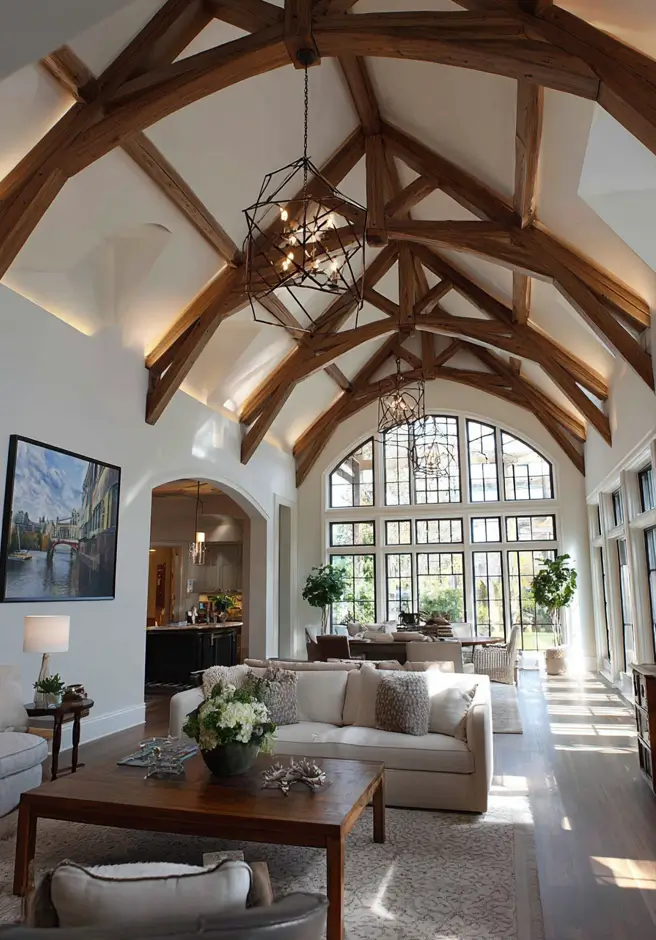
Majestic vaulted ceilings with intricate wood trusses define this great room. Bright white walls and a towering arched window flood the space with light, preventing the woodwork from feeling heavy. Modern geometric chandeliers add a contemporary edge to the classic Tudor architecture.
5. Mix Rustic Beams

Exposed, rustic ceiling beams provide a powerful architectural counterpoint to soft, neutral walls. A classic fireplace mantel, painted in a modern blue, is paired with contemporary seating, creating a space that feels both grounded and light.
6. Soften Stone Elements

Massive stone fireplaces and dark ceiling beams are foundational to Tudor style architecture. Counter this inherent weight with soft, sculptural furniture in light tones. A high-pile rug and bouclé chairs add textural warmth and a modern sensibility, perfecting the modern Tudor interior design.
7. Use Bold Color
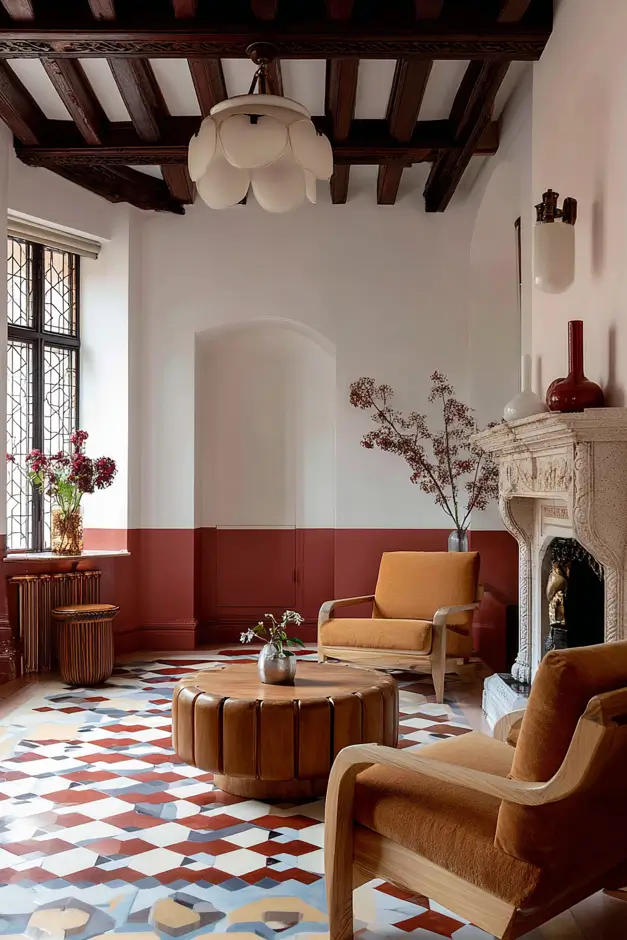
Classic Tudor architecture, like the carved fireplace and dark-beamed ceiling, creates a stunning backdrop for bold, modern choices. A two-tone wall in contemporary colors and a geometric floor tile add an artful, unexpected layer to the historic space.
8. Warm Up Timber Frames
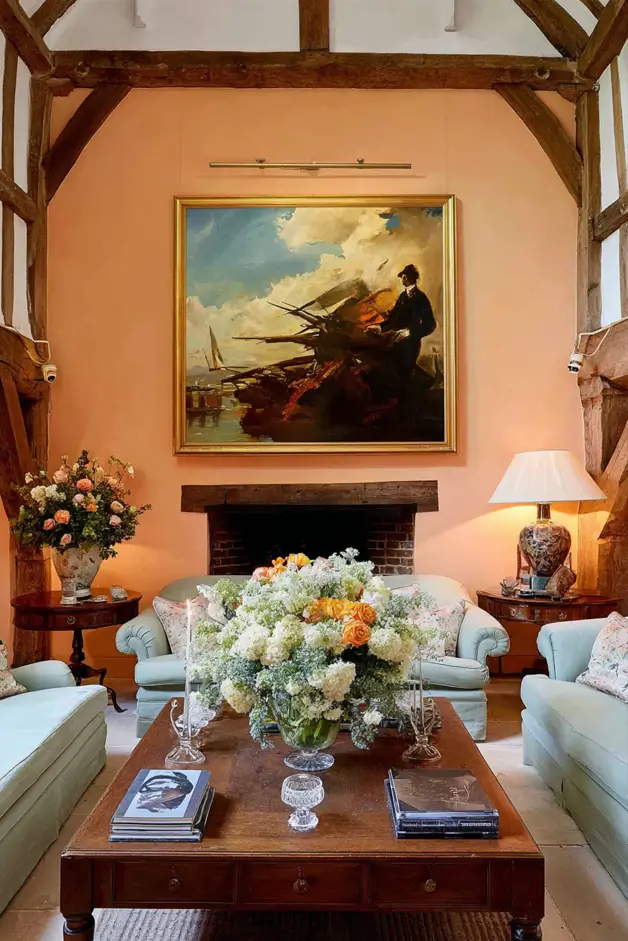
Heavy, rustic half-timbering, a core Tudor element, is beautifully softened by a warm, contemporary wall color. This approach prevents the dark wood from overwhelming the room, creating an inviting backdrop for classic furnishings and a statement piece of art.
9. Mix Ornate Stone

Ornate, carved-stone elements, like this grand fireplace and arched doorway, are quintessential Tudor features, reminiscent of details often found in classic British country houses. Balance their historic weight by pairing them with light neutral walls and plush, modern furnishings, creating a sophisticated dialogue between old and new—the very essence of modern Tudor interior design.
10. Embrace Eclectic Style
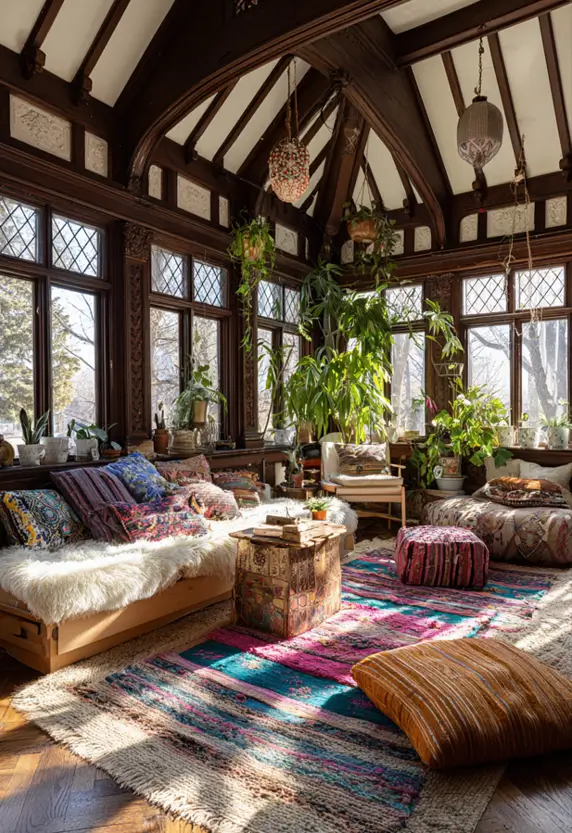
Ornate Tudor architecture, with its carved beams and leaded-glass windows, creates a dramatic backdrop for a contrasting style. A bohemian approach with layered textiles, floor cushions, and abundant greenery softens the home’s historic formality.
In Kitchens & Dining Nooks
11. Contrast Paneled Nooks

Richly paneled dining nooks, complete with leaded-glass windows, are classic Tudor features. Contrast this heavy woodwork with sleek, modern furnishings, like velvet chairs and a minimalist table, to create a sophisticated, updated modern Tudor space.
12. Pair Deep Colors
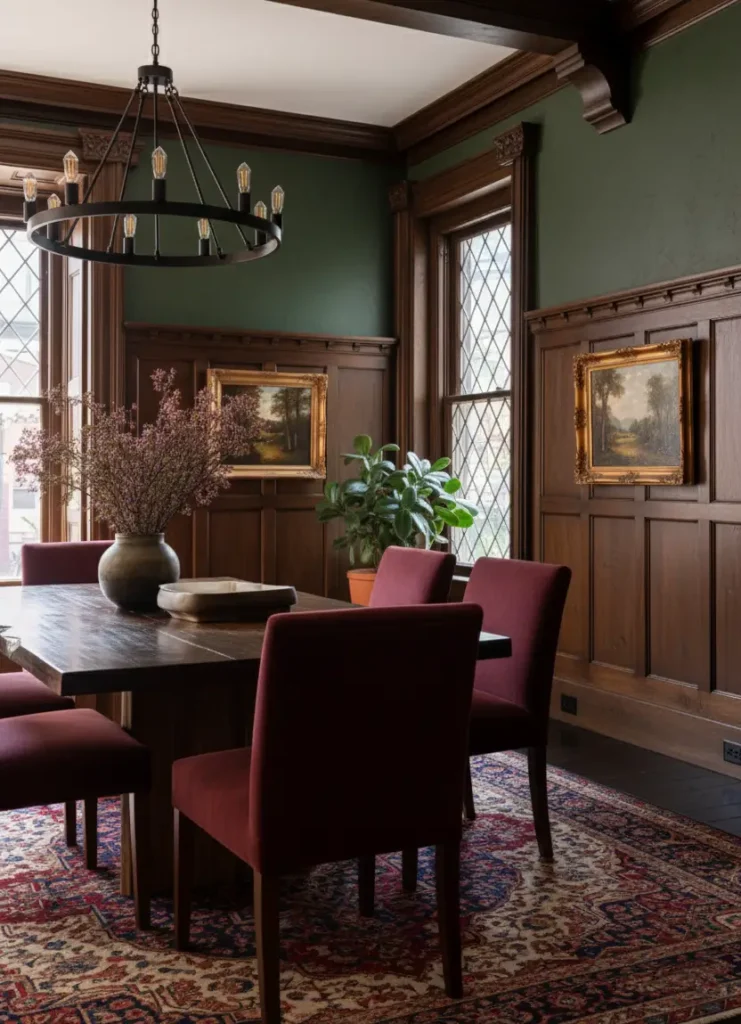
Rich wood wainscoting paired with deep green walls creates a dramatic, enveloping effect. This classic Tudor backdrop is modernized with bold, burgundy chairs and a simple iron chandelier, proving that moody colors can feel both historic and current.
13. Blend Kitchen Colors

Rich color-blocking, a popular feature in many modern open kitchen designs, modernizes this modern Tudor kitchen. Deep green on the island and blue on the upper cabinets create a sophisticated palette, all anchored by a rustic, wood-beamed ceiling and a warm butcher block countertop.
14. Update Kitchen Cabinetry

Dark, moody paint modernizes traditional kitchen cabinetry. This deep green-black, paired with a marble waterfall island, feels sophisticated. A classic-leaded-glass window in the background honors the home’s Tudor lineage.
In Bedrooms & Bathrooms
15. Frame Modern Fixtures

A large, arched window with traditional leaded glass finds a modern counterpart in a sleek, freestanding tub. By keeping the surrounding walls a soft, neutral gray, the window remains the undeniable focal point, while the minimalist tub feels intentional and serene—a hallmark of successful modern Tudor interior design.
16. Create Airy Bedrooms

Vaulted ceilings with exposed, rustic trusses bring immense character to a primary bedroom, a hallmark of Tudor house interior design. Keep the walls and bedding in soft, light neutrals, one of many cozy bedroom ideas to maximize the natural light from tall, black-framed windows, ensuring the space feels serene and open.
17. Layer Textural Neutrals

Textured plaster walls and rustic ceiling beams create a serene, historic backdrop. This Tudor-inspired bedroom is softened with layers of natural linen bedding and a high-pile rug, creating the rich and inviting feel often celebrated in charming English cottage house designs.
18. Create Moody Bedrooms
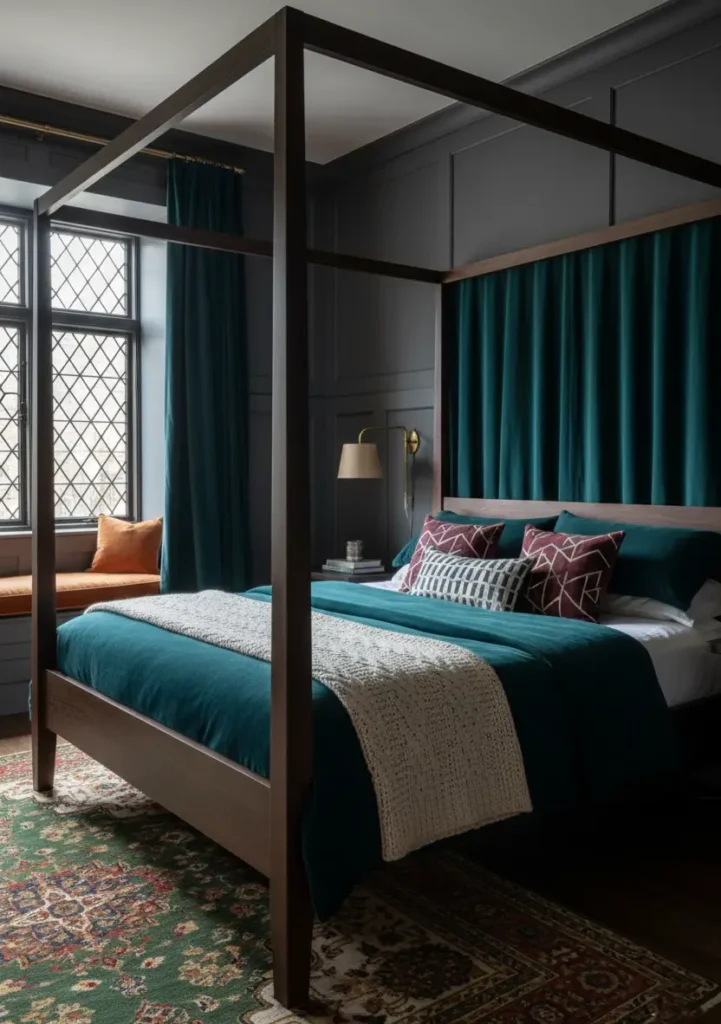
Diamond-pane leaded-glass windows are a Tudor signature. Lean into their historic feel by using a dark, enveloping color palette. A modern canopy bed and rich velvet textiles create a sophisticated, moody retreat that honors the home’s Tudor character.
19. Paint Ceiling Insets
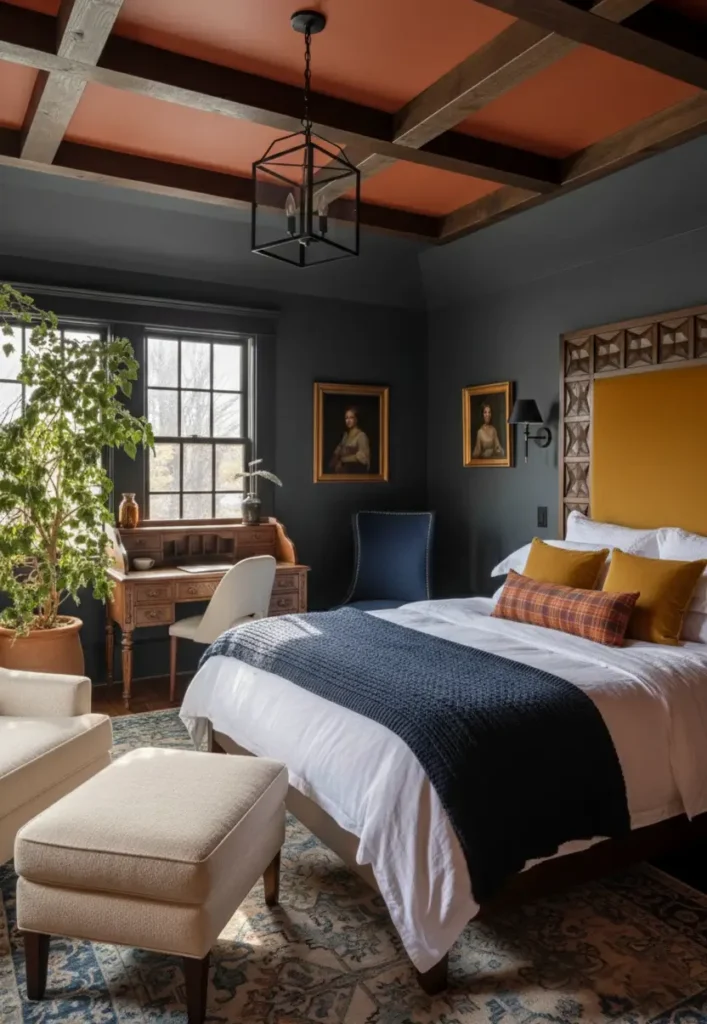
A coffered ceiling, a traditional Tudor feature, is given a modern update with a painted inset. This unexpected splash of color draws the eye up, while dark walls and classic art create a sophisticated, layered bedroom.
In Entries, Libraries & Architectural Details
20. Highlight Wood Features

Original elements, like exposed beams and intricately carved shelving, are the heart of a Tudor home. Pair this rich woodwork with crisp white walls to prevent it from overwhelming the space, creating a clean backdrop. Modern seating and soft textiles introduce comfort and light.
21. Embrace Ceiling Architecture

Dramatic ceiling beams are a defining element of a Tudor style house interior. Painting the surfaces between them a crisp, bright white creates a striking graphic contrast. This technique highlights the intricate woodwork and reflects light, preventing the room from feeling heavy.
22. Highlight Grand Arches
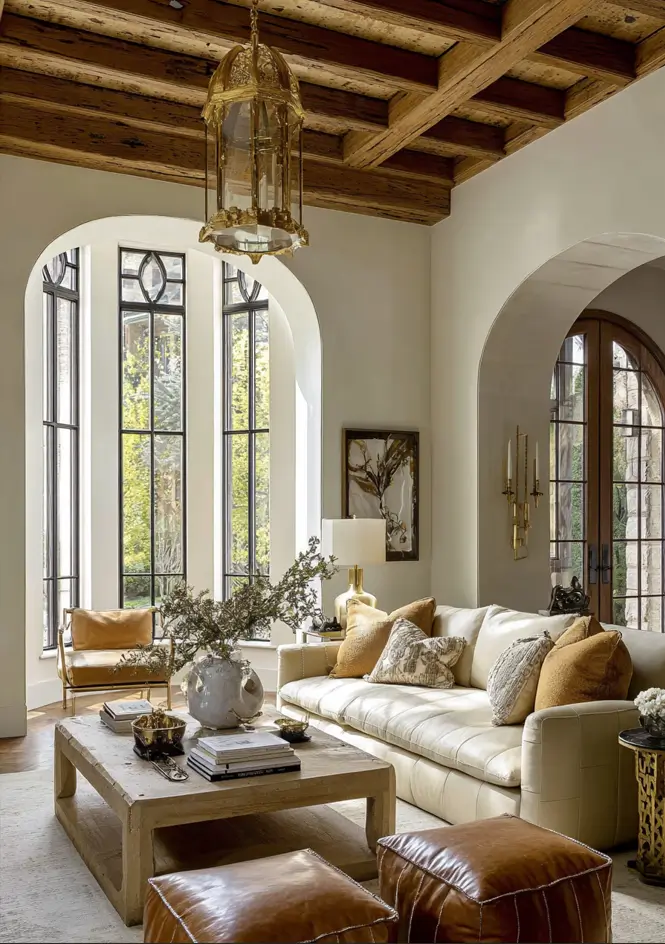
Grand architectural arches are a signature of Tudor design. Soften their visual weight by painting surrounding walls in a warm white or light neutral. This approach highlights the elegant shape while allowing modern, plush furnishings to create an inviting atmosphere.
23. Lighten Grand Stairways
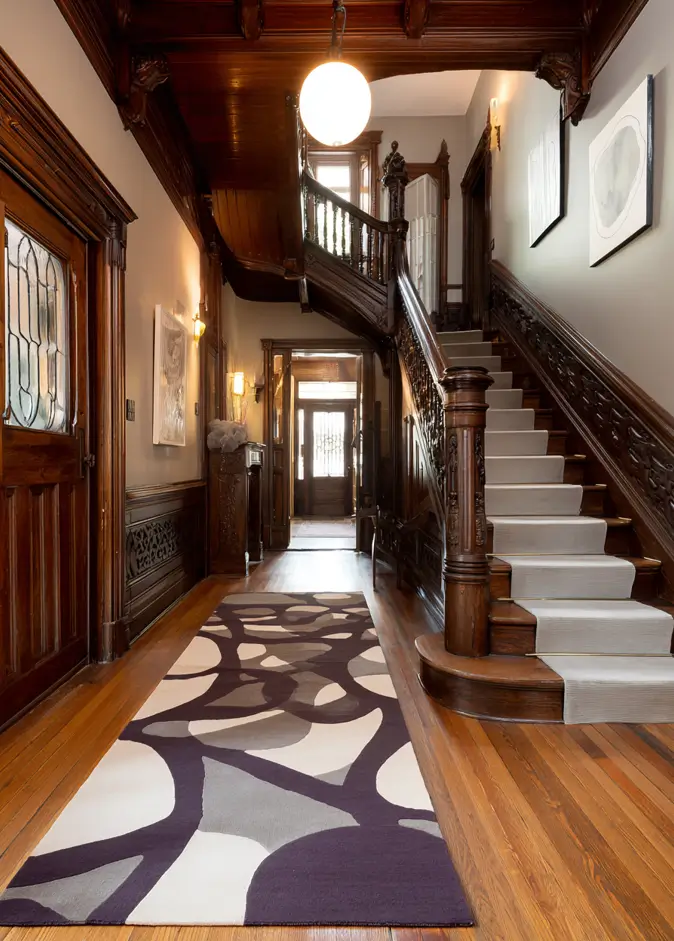
Grand stairways in dark, carved wood are magnificent but can overwhelm an entry. Introduce a light-hued stair runner to create a-bright visual path. This simple addition, paired with a contemporary rug and modern lighting, effectively balances historic weight.
24. Use Monochromatic Color
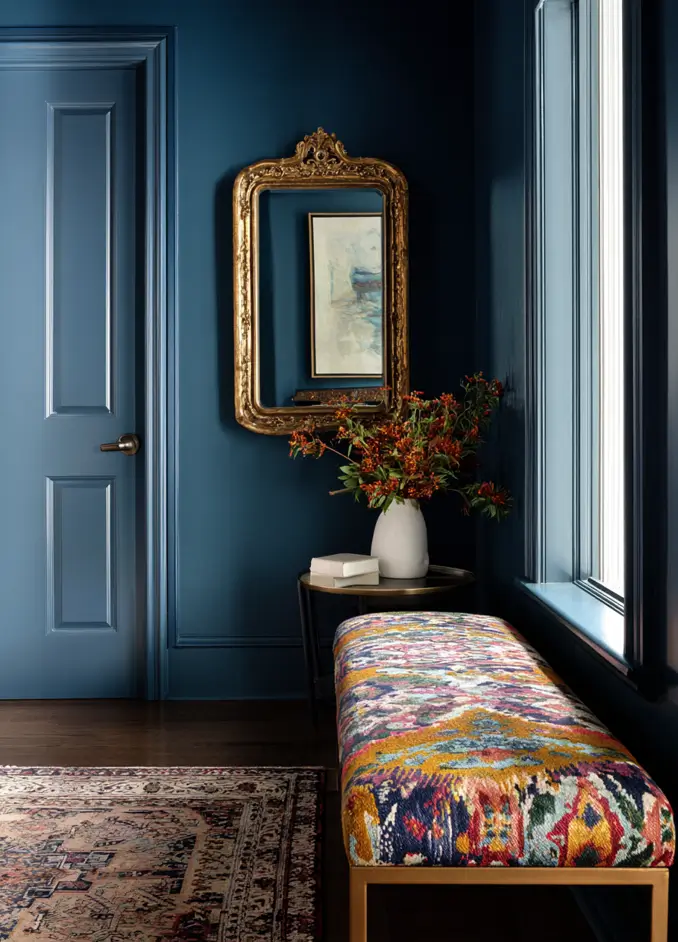
Lean into a sense of history by drenching an entryway or small room in a single, moody hue. This monochromatic approach modernizes the space and creates a dramatic backdrop for contrasting elements, like a gilt mirror and a brightly upholstered bench.
25. Embrace Moody Tones

Instead of fighting against dark, historic wood paneling in a Tudor style house interior, embrace it. A deep-hued velvet sofa and tone-on-tone accessories create a rich, layered, and sophisticated lounge. Modern brass lighting and art add a necessary bright counterpoint.
26. Contrast Rustic Ceilings
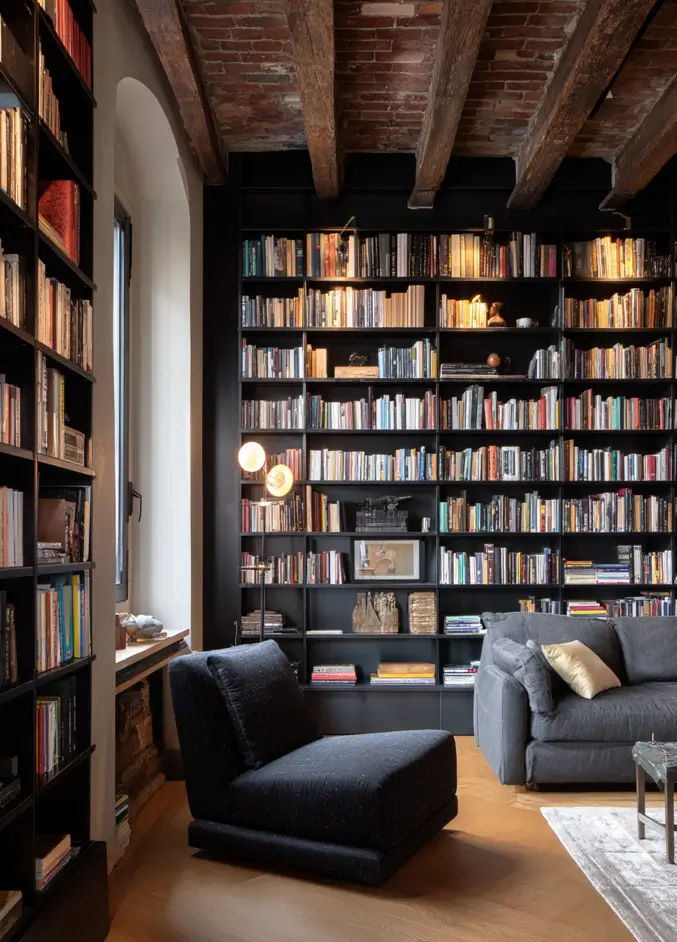
Exposed brick and raw ceiling beams create an immense textural backdrop for this modern library. Sleek, black floor-to-ceiling shelving provides a sharp, contemporary contrast, proving that modern inserts can highlight, rather than hide, historic character.
27. Modernize Stair Structures
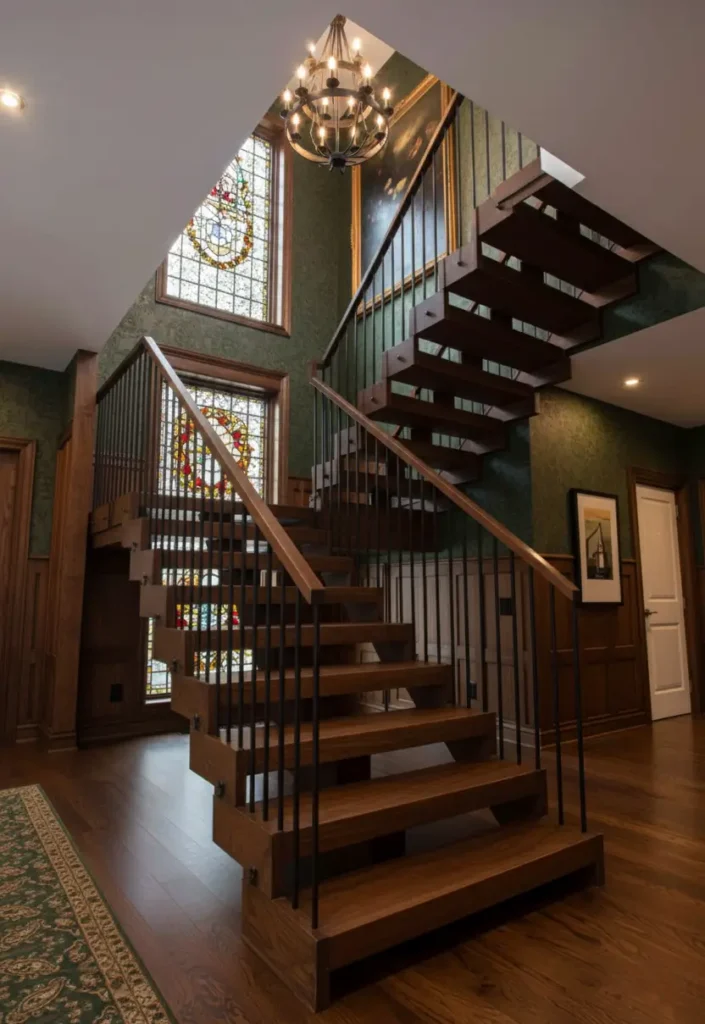
Stained-glass windows, a Tudor staple, provide a historic backdrop for a contemporary floating staircase. This direct-pairing of modern engineering with classic materials creates a striking focal point, proving that even structural elements can be reinterpreted.
28. Moody Modern Entry

Leaded-glass windows and a heavy, carved mirror set a historic tone in this entryway. Modern, clean-lined sconces and a simple console table provide a sharp, effective contrast, proving that the modern Tudor look is about balance.
29. Modernize with Color
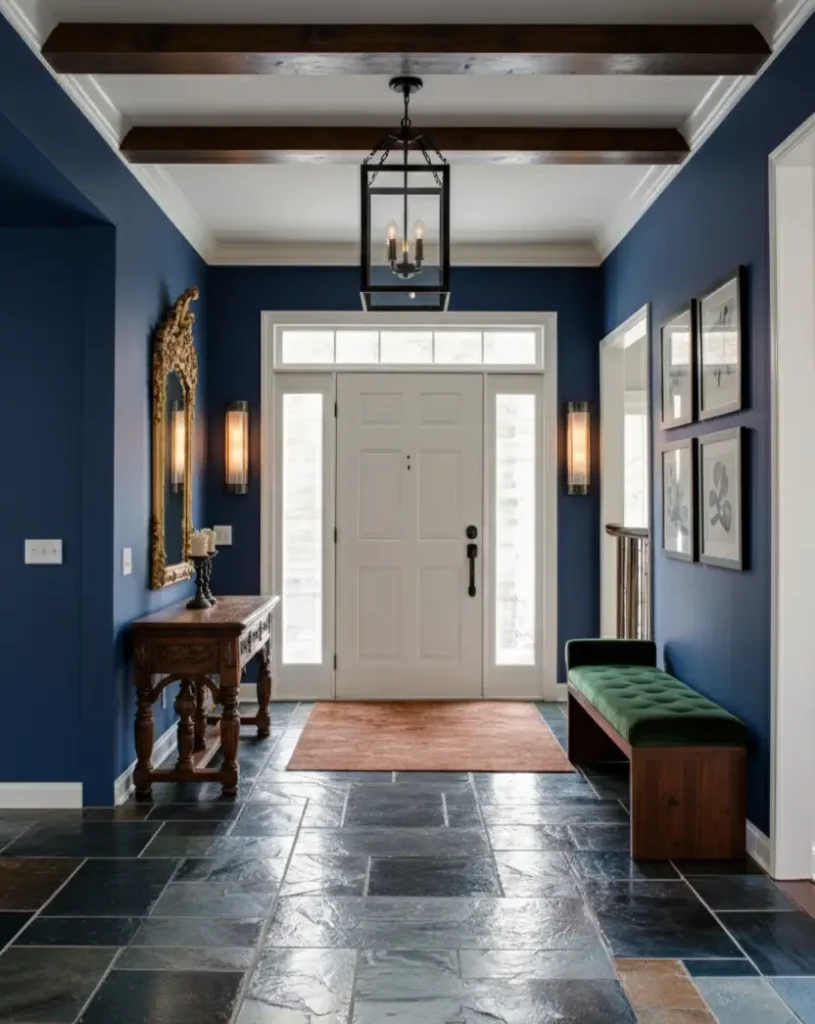
Exposed ceiling beams and a natural slate floor ground this entryway in classic Tudor weight. A deep, saturated blue on the walls provides a modern, sophisticated backdrop, brilliantly contrasting with the bright white door and traditional gold-leaf mirror.
Get the Look: Modern Tudor Style in Any Home
Even if your home doesn’t have 16th-century bones, you can still embrace the modern Tudor spirit. The focus shifts from preserving architecture to thoughtfully adding character and contrast.
- Embrace Moody Color: Use a deep, saturated color like the navy blue or forest green seen in the examples. Painting the walls, or even just a single accent wall, instantly creates the sophisticated, enveloping feel of a Tudor library.
- Add Textural Wood: Introduce the style’s signature material with furniture. Look for a rustic, heavy wood dining table, a substantial sideboard, or a large, intricately carved-frame mirror to serve as an anchor piece.
- Incorporate Rich Textiles: Layering is key. Introduce velvet upholstery, leather armchairs, and high-pile wool rugs in deep, rich colors. These textiles add the necessary warmth and material weight.
- Hint at the Architecture: You can nod to Tudor forms without a full renovation. Use mirrors with diamond-shaped panes, place a bookcase with a subtle Gothic arch against a wall, or use modern black framed mirrors to mimic the leaded-glass look.
A Designer’s Guide to the Modern Tudor Look
Achieving this look, a cornerstone of modern Tudor interior design, is a study in balance, not imitation. Begin by assessing your home’s original features and follow these core steps.
- Start with Contrast. Celebrate the grounding elements of dark beams or stone fireplaces, but use light, neutral paint on surrounding walls—a technique perfected in modern farmhouse decor—to reflect light and create a fresh, modern backdrop.
- Celebrate the Architecture. Treat leaded-glass windows, carved doorways, and grand staircases—the heart of a Tudor house interior design—as the focal points. Keep furnishings around them simple so these original features can stand out.
- Layer with Soft, Textural Neutrals. Soften the hard, historic materials (wood, stone) with a plush, light-colored rug, a bouclé sofa, or linen curtains. This prevents the space from feeling cold or austere.
- Choose Specific Modern Furniture: Counter the historic weight with clean, contemporary silhouettes. Look for pieces like Scandinavian-style armchairs, minimalist sofas, or Mid-Century Modern consoles.
- Use Lighting as a Feature: Swap heavy, traditional iron chandeliers for airy, geometric pendants or minimalist brass sconces. Modern lighting acts as a sculptural element that balances the ornate architecture.
Common Mistakes to Avoid
As a designer, I’ve seen that the line between “timeless” and “themed” can be thin. Achieving this look is about a sophisticated, light touch. Here are a few common pitfalls to avoid.
- The “Theme Park” Look: Avoid imitation materials at all costs. Faux-plaster stucco walls or overly plastic-looking “wood” ceiling beams can cheapen the look and miss the point, which is to celebrate authentic, high-quality materials.
- Ignoring the Light: Classic Tudor homes are notoriously dark. Do not compound this by using heavy, dark drapes or blocking windows. Opt for light, airy linen curtains or keep windows bare to let in as much natural light as possible.
- Creating a Museum: The “modern” part is key. While one or two true antiques can add immense character, the rest of your furniture should be contemporary and, most importantly, comfortable. This is a home to be lived in, not a historical reenactment.
Frequently Asked Questions
What defines modern Tudor interior design?
Modern Tudor interior design is a style defined by contrast. It honors classic architectural features (like dark wood beams and stone) by pairing them with bright neutral walls, clean-lined furniture, and modern lighting to create a fresh, light-filled space.
How can I make my Tudor house interior design feel brighter?
The key to brightening a Tudor house interior design is to maximize and reflect light.
- Use Contrast: Paint walls a crisp, warm white to contrast with any dark wood beams or trim.
- Update Lighting: Replace heavy or dated fixtures with modern, airy pendants and sconces.
- Keep Windows Clear: Use minimal window treatments, like sheer linen, to allow for maximum natural light.
- Add Light-Hued Textiles: Incorporate large, light-colored rugs to brighten dark floors.
What are the best colors and materials for a Tudor style house interior?
For a Tudor style house interior, focus on a palette of contrast. Use warm whites or soft linens on walls to offset dark wood. For accents, use deep, saturated tones like forest green, navy, or burgundy. For materials, layer soft, natural textures (bouclé, linen, velvet, leather) to soften the home’s strong architectural elements like stone and wood.
A Final Thought on Timeless Style
Ultimately, updating a Tudor style house interior—much like a modern Victorian style house—is not about following a rigid set of rules, but about creating a dialogue between the past and present. By honoring the home’s inherent character while infusing it with light and modern comfort, you can create a space that is not only sophisticated but deeply personal and timeless.

